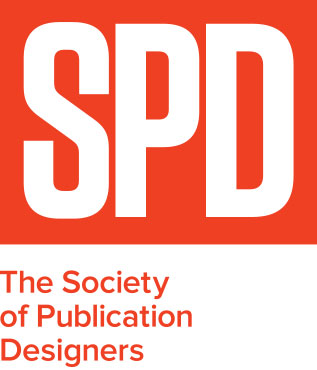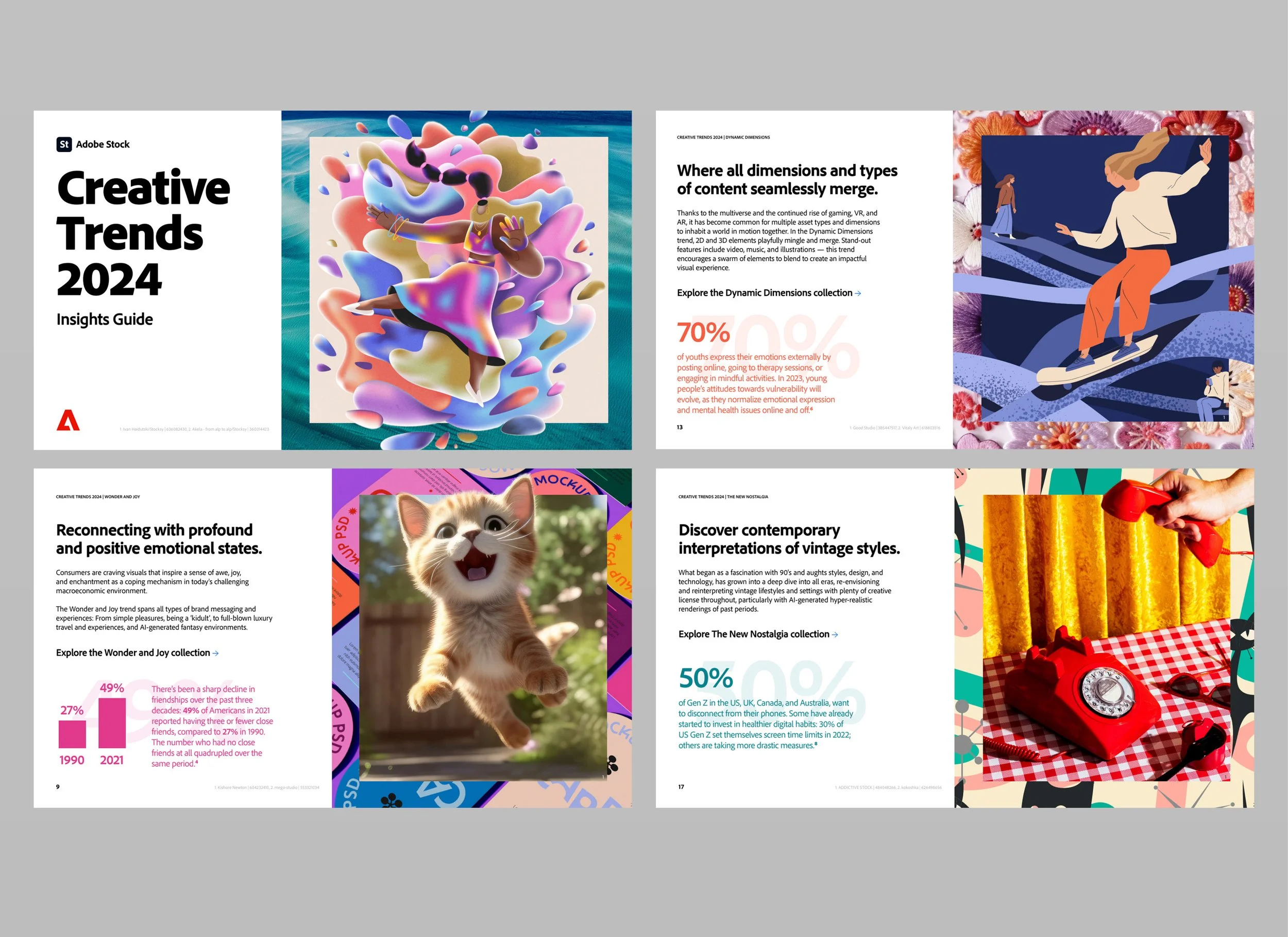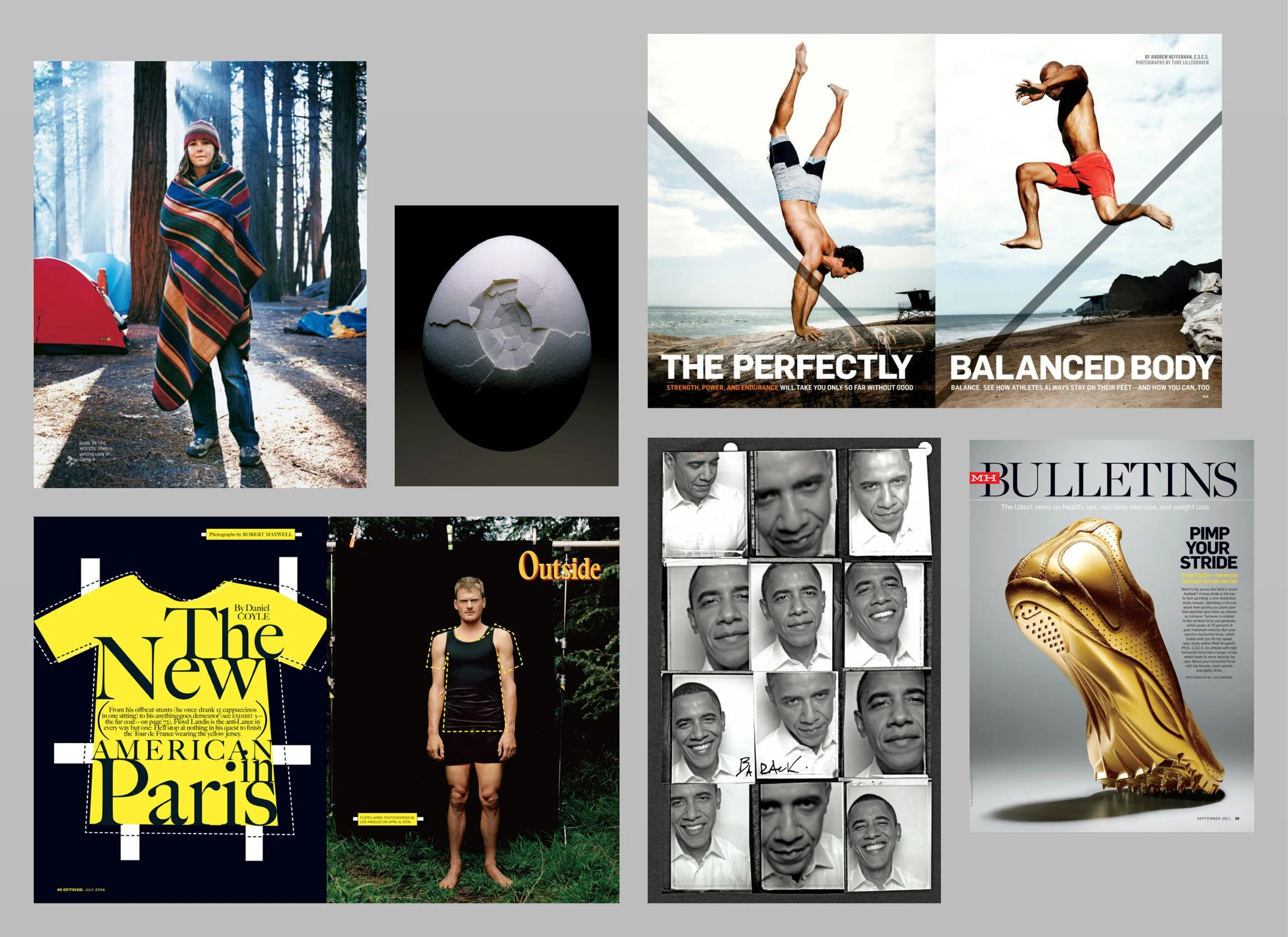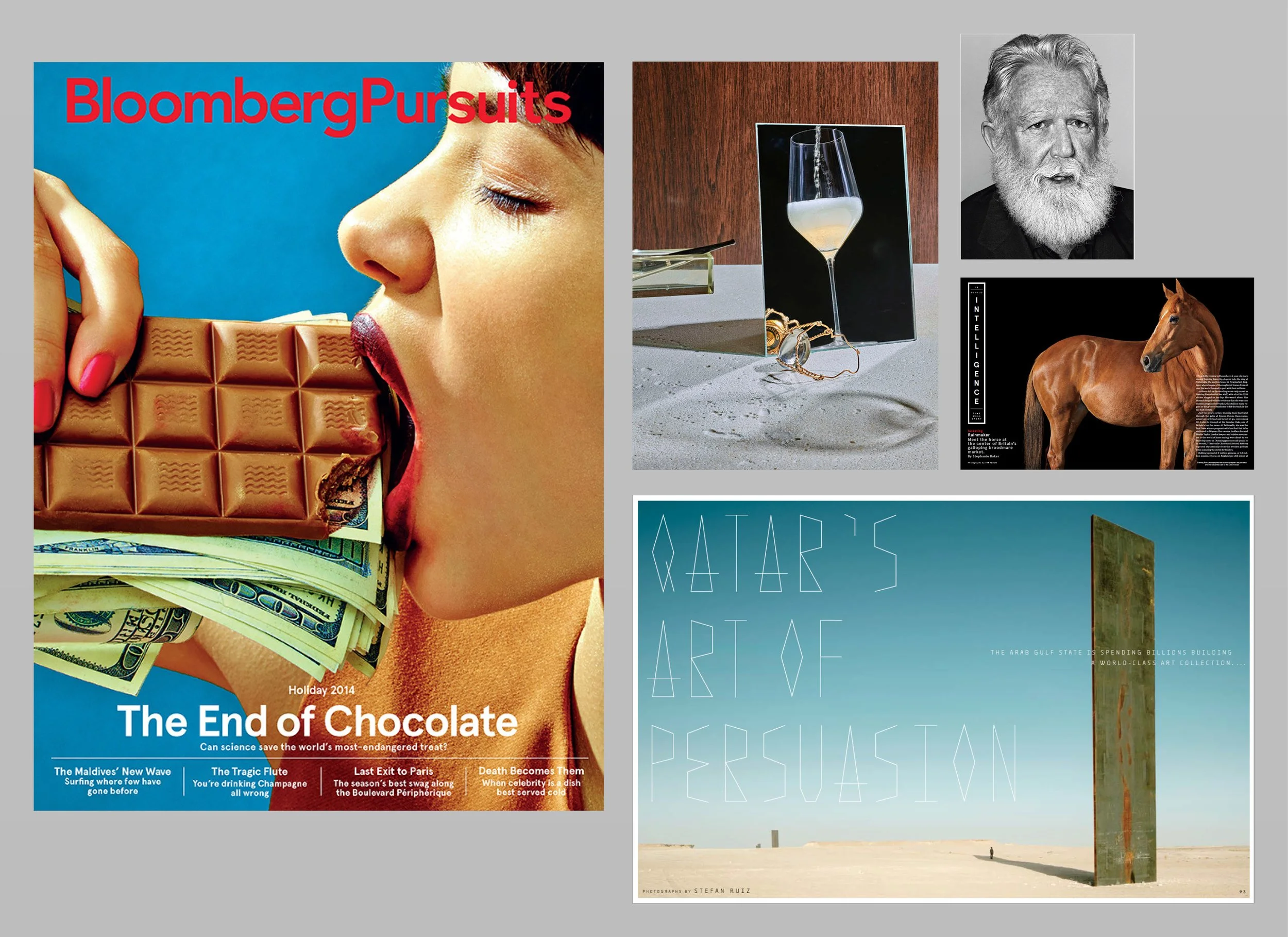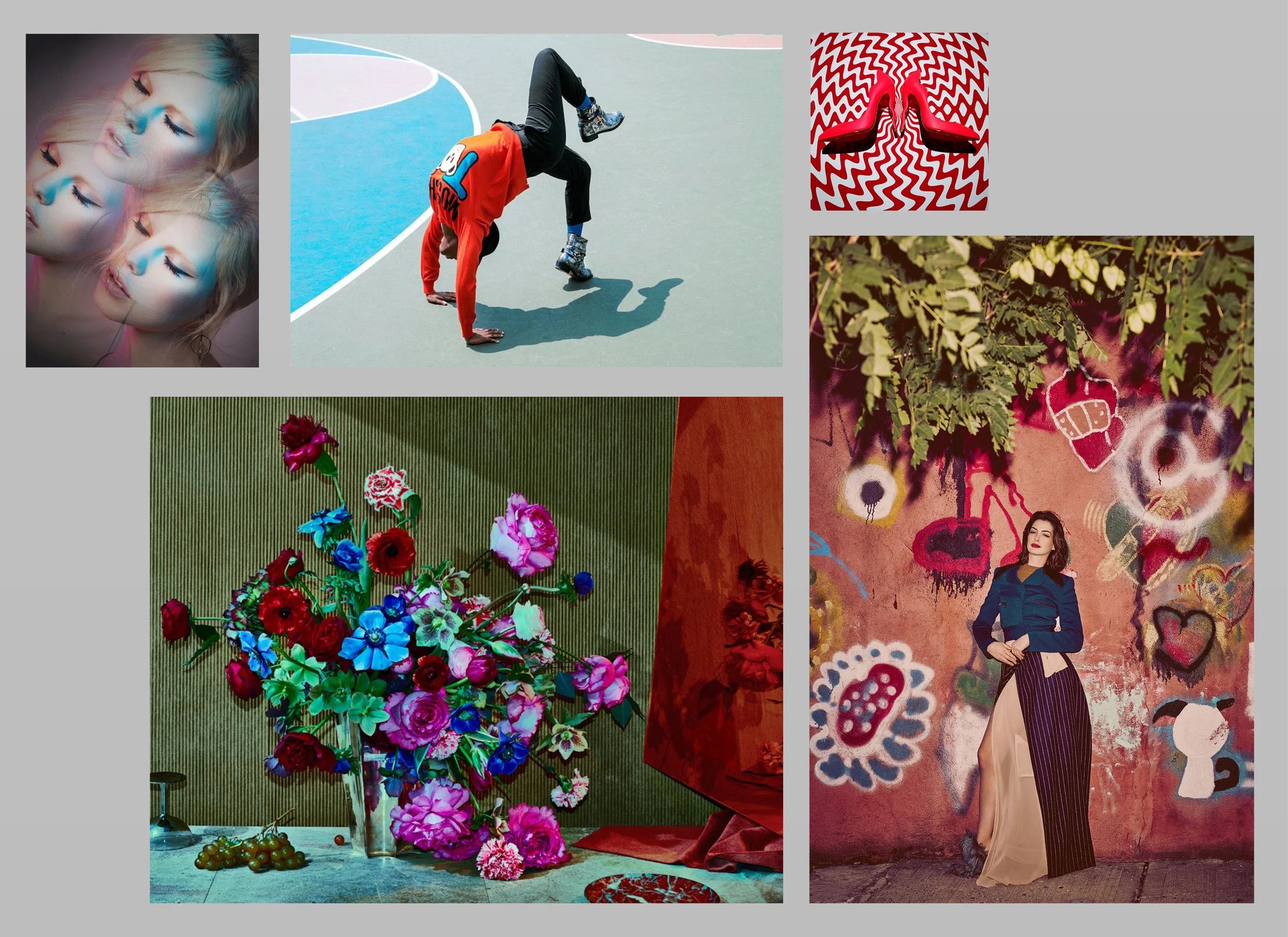(Re)Direction: Brenda Milis, From Magazines to Trend-Forecasting for Adobe
/Brenda Milis in Adobe’s downtown NYC office
Our second installment is a conversation with Brenda Milis, who spent many years photo editing and directing for major magazine brands. For the past seven years, she has been Principal of Consumer and Creative Insights at Adobe, where her well trained eye helps her spot the latest visual trends and cultural shifts to share with other creatives, communicators and brands.
A few sample pages of the 2024 Adobe Creative Trends report. Brenda conducts extensive research year-round, focusing on emerging creative styles, consumer patterns, technology advancements, and stock buyer data to identify emerging visual styles and themes hitting mainstream commercial relevance.
Tell me a little bit about how your path originally took you to photo editing/photo direction for publications specifically. Was this a field you were always interested in?
Growing up, I was a huge fan of fashion magazines; their beautiful imagery and design inspired me for many years. The glamorous and aspirational representations of a big world with a whole range of lifestyles was entrancing to a kid growing up in a sleepy California beach town.
I didn’t think about working for a magazine until I was in Graduate School at the New School for Social Research in NYC. I had my BA in Art History from UC Berkeley and was in a Masters’ program for Media Studies with a focus on the construction of gender. A friend of mine landed an internship at Harper’s Bazaar and I was immediately so envious of her opportunity to work at a magazine that I decided to find an internship of my own! Happily, Jane magazine brought me into their incredible photo department to intern with their Photo Director and that is how my career in photo editing and production began.
What about working for publications (on paper and online) did—and perhaps do—you find particularly appealing?
Well, I just love print publications—the sensorial combination of both the visual and the tactile—there’s really nothing like it for immersing yourself in the look, feel, and world of a magazine.
In terms of working for print media, there is a unique excitement and satisfaction in the ideation and production process: getting a lineup of articles for a new issue, collaborating with art and photo to decide the mood and look of the visuals you want to produce for each piece, choosing a photographer, videographer, (or illustrator), working closely with the artist to produce the shoot, get the images in, work on an edit that hits all the beats needed, and have that published as a magazine you can hold, read, share copies of. A truly beautiful and collaborative experience (with a whole lot of stress and headaches in making it all happen!). All this from someone who has worked in the digital realm for many years now!
You worked at several very different publications in different parts of the country, both in print and online. How did you experience your work and work environment at the time, and how did your work for print and digital media outlets differ?
Here’s a laundry list of where I’ve worked in media for the rainbow of flavors that was my media career from 2000-present:
Jane magazine (intern), Fitness magazine, Style.com/Condenet, Outside magazine (with you, Jana, in Santa Fe, NM!!), Men’s Health, Marie Claire, Time magazine, Bloomberg Pursuits and Bloomberg Markets magazines, Refinery29, Vox, WSJ magazine, Adobe
Brenda worked as the Deputy Photo Editor at Outside magazine (top and bottom Left) from 2003 until 2006. She was Director of Photography at Men’s Health magazine (right) back in NYC from 2006-2011. These are samples of the work she produced with her respective teams. Credits (clockwise from top left): Jeff Lipsky, Mitchell Feinberg, Ture Lillegraven, Levi Brown, Frank Ockenfels 3; Robert Maxwell
My entry into online media began because of an opportunity to launch Condé Net’s site, “Style.com”, the site for both Vogue and W magazines. I mean, who wouldn’t want to dive into that territory for these incredible publications?
I worked there for a few years and then went back to print, needing a break from the frenetic pace of digital startup culture and NYC post 9-11. I was lucky enough to move between digital and print for some time and the work environments are completely different. With print publications—even weeklies—there is a rhythm in terms of getting the lineup for each issue, working on ideation, assignment, and production; there’s a structure and flow even though deadlines can be really tight, last-minute changes are often made, and stress definitely runs high.
In terms of working digitally—whether for media or producing imagery for tech—things are constantly changing. It’s really a roller coaster, and the phrase “we’re building the bridge as we cross it” is used so often because it’s actually true.
Now, because I’ve been lucky enough, hustled enough, and/or tend to follow both my head and my heart, my shifts between digital and print have led me to believe that as much as I truly love print media (and I feel strongly it’s rising again), after so many years following the regular schedule of print publications and gaining experience in the crazy unpredictability of online or digital-only work, I’ve come to prefer the latter as I love the experience of literally building the future. In addition, Adobe is a company that supports creatives and creativity so that’s a true win-win for me.
And what led you to then pivot away from working in media? Can you remember a single decisive moment, or was it a long slow-mo good-bye?
Oh, I absolutely remember the moment when I realized it was time to get out of media.
I was working at Vox to re-brand their style site “Racked.com.” They had virtually no budget. I had come to Vox from Refinery29 and R29 was quite savvy in being scrappy, but knowing where and when to budget real money for certain types of shoots.
It was early in the morning, and I was walking from the subway stop to the Vox office and thinking about how the media landscape continued to change so quickly (this was towards the end of 2016). I was thinking about how digital ad revenue really couldn’t sustain photo and video production; it couldn’t support the kind of quality that really excites and engages viewers. I realized the whole structure of online media just didn’t make sense. Too many stories were being posted online to be viewed or even found.
It just didn’t add up. The ambitions of online media didn’t make sense, particularly for those sites that were attached to print publications but were producing content that had nothing to do with what was being published in print. There was no overall brand-look, voice, or feel. I had even talked about this problem with a few HR leads at major publishing companies. They were pretty dismissive. It’s as if it made no sense to them to create a world out of their brand—one that was cohesive no matter where their content was shared. During that quick morning walk to work, I knew I had to start looking beyond media which made me very sad, yet grateful for the clarity as I’d been wondering how to continue to develop my career for some time.
What sorts of options did you consider, if any? Or was the path to your current job very clear?
Frankly, I didn’t know what to do or where to go. So I just leaned into LinkedIn and began reaching out to every creative I knew. After about 4 months while I continued to work, I landed at the nascent Adobe Stock, much to my delight.
Samples of work produced by Brenda and her team at Bloomberg Pursuits, a quarterly luxury magazine where she was the Director of Photography from 2012-2015. Credits (Clockwise from Left): Maurizio Cattelan and Pierpaolo Ferrari; Thomas Prior; Richard Burbridge; Tim Flach; Stefan Ruiz
What does your job entail now?
While I work specifically for Adobe Stock, as part of the Creative Cloud the imagery we produce and acquire provides visuals for all of the apps and Adobe Express.
My title is Principal of Consumer and Creative Insights: I lead research for Adobe Stock; identifying the kinds of imagery (whether photo, video, illustration, Generative AI images, and more) rising in commercial relevance and viewer engagement. In a nutshell, I’m a trend forecaster. I serve as a content strategist, providing thought leadership for both our customers and contributing artists to help them develop their work and evolve their brand in alignment with the styles, aesthetics, and themes rising in media presence and consumer appeal.
Because the world and visual landscape are changing at an incredibly fast pace, my role is to provide data and research to support Adobe’s own content acquisition and to support creatives in their own project planning. I really love it, frankly.
Are any skills that you learned during your years in publishing applicable to your current role?
There are probably quite a few since we live in a visual culture and world. No matter what type of creative project that has a visual focus you work on, you are continuing to present in a style that audiences and viewers have learned to respond to. I think of visual messaging as a language. In fact, communicating in pictures and design feels just as much like my ‘native tongue’ as written and spoken language.
Everyone is marinating in visual culture, then as creative professionals and now as ‘content creators’. We learn how to work with visuals as language—we become more fluent than most. Those of us who want to be in this professionally over the course of our career continuously learn how to develop and evolve that language; i.e. stay up-to-date on how still and motion imagery and design are changing and why in order for our work to stay relevant and engaging—vs. becoming stale, dated, redundant and uninspired. Evolve, don’t get stuck in repeat. It’s important to have a lifelong learning mentality. We are living in a time where people always need to update their skills and pay attention to what the current standard expectation is.
Okay now I’ll actually answer the question directly. These are the big elements or skills that transfer directly from my time in media to my current role:
My work in photo direction, editing, and production has always revolved around the question of how do I tell the story with imagery that will be true to the written word as well as engage and retain viewer attention. How do I visually tell the story that I’ve been given to illustrate (choose an artist to shoot it that fits and may be a bit surprising, exciting, inspiring and give someone whose work I love a chance to show their amazing talent); Or, if I’m working with stock and licensing, get ready to spend some hours finding the right imagery.
Also central is knowing how I can elevate and evolve the brand I work for (magazine, website, client). This has always been my headspace in every job; how can I improve the brand’s look and feel while staying loyal to its voice, audiences, etc? All while continuing to improve and evolve the brand, to keep it fresh, exciting, relevant, surprising and push it consistently into the future to grow its audience and stay up to date with a changing world and culture. This is how I got so darn interested in visual and creative trends and dove into them many years ago while being a photography director.
Going digital earlier than most, brenda was one of the founding photo editors of condé net’s “Style.com”. After years of working for print publications after, she re-entered digital media as executive photo director of Refinery29 (samples of that work are shown here). credits (Clockwise from top left): Brooke Nipar; Rockie Nolan, Mitchell Feinberg; Guy Aroch; Kiernan Monagham
What are some major achievements or favorite parts (maybe they are not the same) in this new line of work?
This line of work—being a creative and content strategist—doesn’t feel new to me anymore because I’ve been at Adobe for almost seven years, but it does feel very distinct from the work I did in media before coming to tech, yes.
First, I enjoy my work with Adobe customers because really, they are all creative professionals and I think the information I can bring to them—both generally and specifically to their own brand or company—gives them a very informed and fresh perspective from what they are hearing and seeing within their own company. And this helps them feel excited to move forward with their work. That’s a great feeling and fuels my own passion for what I do.
The second part of my role that is equally compelling is how my work has an impact on the ongoing evolution of Adobe Stock and Adobe content: By sharing my research and insights around cultural shifts that affect the kinds of visuals our customers are becoming more interested in, how content tastes and demand is evolving. My work helps drive the development of our stock offering as well as helps train the generative abilities of Firefly (Adobe’s Generative AI model) to meet the evolving visual needs of our customers.
If you could chart out your trajectory until retirement (if you believe in retirement), what are important stations and/or goals still ahead for you?
The irony isn’t lost on me that my forté is forecasting shifts and changes in the creative landscape yet seeing where my own professional future as a creative is extremely difficult. And that’s because I have a range of tried and true techniques and skills for the former but working across many years as a creative professional is very different from conducting objective research.
In addition, I have learned (begrudgingly) that I only have so much control over the specifics of my career. It’s important to note that while my professional history looks like a straight path from the outside, the lived experience has been an almost constant hustle and staying alert to opportunities for growth.
What I can do is list my consistent career priorities:
Look for work that feeds your passion and your heart: for me that’s working with imagery and other creatives. Working with corporate creatives for me is just like working with editorial creatives: we all want to make exciting, beautiful, work and we love collaborating with and supporting each other. That remains a constant delight and hope I never lose that thrill.
Be willing to work for free in the very beginning if necessary to get your foot in the door, understand that you are a beginner and that it takes time to develop your skill set and your career. After you have established yourself in the industry, make sure you get paid for your expertise. I have always known that I bring a lot of talent to my work because I have a very strong skill set via education and a wide variety of work, a ton of passion and loyalty, and I am willing to give whatever it takes to do a good job for my employers.
Always be willing to learn from everyone around you. That’s key, and I really love working in a multi-generational environment because each age group has a very different perspective, cultural experiences, and skills to offer. Also, if I stop learning I stop collaborating and that’s what keeps us excited about this work. I reckon really live by “get busy living or get busy dying” in both my professional and personal life. It’s probably why I love living in NYC so much—there’s always so much to take in, consider, and then share out to a range of internal teams at Adobe and customers in my own work.
How do you feel the media industry and the work entailed with it has changed over the years in the country you reside in?
The media industry in the U.S. is basically unrecognizable to me from where and when I began over 20 years ago. This is why I committed to creating an exit plan back in 2016. From my perspective, to produce high quality, compelling and exciting media coverage—both words and imagery—you need a strong budget, just like any major industry.
I was always a huge fan of ads in magazines because that paid the bills, that kept the lights on and for me. It also reflected the zeitgeist of the season and culture so ads were and remain great resources to stay in touch with what a wide range of industries are betting their audiences will respond to and create brand loyalty. I literally watch and study ads and commercials in print and on tv (yes, I stream platforms that run commercials on purpose and have subscriptions to sites that run commercials from around the world and use these in my work now) to track trends across multiple sectors. So yeah, I’m one of the only people who doesn’t groan when Amazon Prime and Hulu run ads.
I am seeing a growing interest in print publications now; particularly with Gen Z but also across all age groups because so many of us are tired of looking at screens all day. But in order for the business of print publications to really flourish once again and not stay in the ‘zine zone’, a real business strategy and budget needs to be built. People really long for more analog experience and we live in a time where more and more people are trying to balance digital and analog. It would be a perfect time to push print; particularly with Gen Z growing up and earning money.
People want to feed all their senses, not just their eyes. Hence the explosion of podcast popularity (close your eyes after a day on screen and listen) and IRL immersive experiences and events (think the Sphere in Las Vegas, the traveling immersive art exhibits like Van Gogh, the resurgence of raves, immersive music concerts and amusement parks, etc) because they are sensorily starved from digital lifestyles.
I’m interested to see where media goes from here. There’s so much talent and we’re back to a place where there’s a big appetite for content that isn’t so much fluff. I’m not proposing long-form journalism because I don’t think most people have the patience and focus for that since we’ve all been trained by social media. But I will venture to say that many young people are looking for alternatives to create a balance in their media diet.
Follow Brenda Milis on Instagram @bam11215
